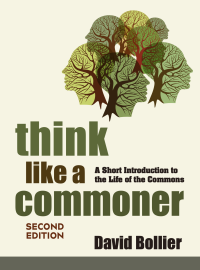Physicists and complexity theorists have a term for the moment when a liquid suddenly transforms into a gaseous state. It’s called a “phase transition.” A phase transition is not a linear, predictable change, but a sudden shift from apparent chaos and randomness to a “sweet spot” of dynamic equilibrium. The idea of a phase transition comes to mind when I look at the declining credibility and reputation of conventional mass media, especially television and radio, and the fierce proliferation of make-your-own creative genres. When will the phase transition to a new paradigm occur?
The sooner the better, if you ask me. Commercial TV is a morass of tawdry reality shows, smarmy sitcoms, kitschy and formulaic dramas, mud-wrestling pundits, and news that has all the gravitas and insight of a corporate Politboro. All of this is interspersed with 20 minutes of advertising an hour and subsidized by broadcasters’ free use of the public’s airwaves. Now that broadcasting has been almost wholly deregulated, you have to scratch pretty hard to find serious news and public affairs shows, challenging arts and culture programming, locally produced shows, educational shows or children’s programming. The market has spoken.
Given the lamentable decline of the mainstream media, the appeal of the emerging make-your-own culture should be obvious. The new culture consists of blogging (amplified by blog syndication and news aggregators); collaborative websites and archives; social networking software; meta-tagging innovations like Flickr, the photo-sharing site, and Del.icio.us, the social bookmarking system; “ podcasting,” (syndication of iPod music playlists) and videocasting (uploading of indie video shorts), remix music, and more. This universe of rip-mix-burn creators is only going to grow as digital technologies become cheaper and more accessible.
Now that there are eight million bloggers, a new networked culture of samizdat news, opinion and gossip is reaching a critical mass. According to a survey by the Pew Internet and American Life Project, readership of blogs rose to 32 million people in 2004, a 58% rise over the preceding year. There is even a conference this weekend at Harvard called “ Blogging, Journalism and Credibility.” The growth of this new genre is so great that Dan Gillmor, the respected high-tech journalist and author of We the Media, has left his day job at the San Jose Mercury News to begin a new web-driven project to foster “grassroots journalism” by “citizen-journalists.” Silicon Valley blogger and old friend J.D. Lasica talks about the “personal media revolution” and the rise of participatory journalism.
Then there is the explosion of remix creativity, which seeks to reclaim art and culture from the “professionals.” Hip-hop was an early pioneer of the promiscuous sampling of any music or ambient sound that was interesting, but now that hip-hop was become Big Business, the lawyers and suits moved in, and any sampling, no matter how short in duration or unrecognizable the source, is illegal (according to the Sixth Circuit Court of Appeals, in a recent ruling that some predict will ruin hip-hop).
Still, remix ain’t going away. It got a big boost from a recent Creative Commons remix contest hosted in conjunction with Wired magazine. CC is hosting an experimental website, CC Mixter, that invites people to assemble a commons of legally usable music samples and remixes. Here’s a description from a Slashdot.org posting about the site:
“The site creates a tree of remix/sources inline with every entry and has Flikr/del.ciou.us style tagging. The launch includes two remix contests and features samples and cuts put in the Commons by Chuck D., Beastie Boys, David Byrne, Danger Mouse and tons more. The winners end up on Chuck D.‘s next CD and a CC promo disk and there’s already been some pretty astounding entries. Of course every upload is under a CC license that allows legal sampling including contest entries and the big name source tracks and samples.”
The project is part of a Creative Commons Tools open source project, which hopes to support remixing of any media including images, videos and Flash mods.
To be sure, the make-your-own culture is all over the map. It remains abundantly unclear which new software architectures, creative formats and culture styles will become popular and endure. Perhaps the larger question is how the proprietary, mainstream media will adapt to this new environment. After all, the participatory culture poses a big threat to the business models of broadcasters, newspapers, Hollywood and record labels. The cultural insurgents also have some very different ideas about how creativity should be owned and controlled.
I’m hoping that a few new pieces in the mosaic will clarify what the emerging cultural paradigm will look like, and when a phase transition may happen. In the meantime? Struggle and confusion.











Recent comments